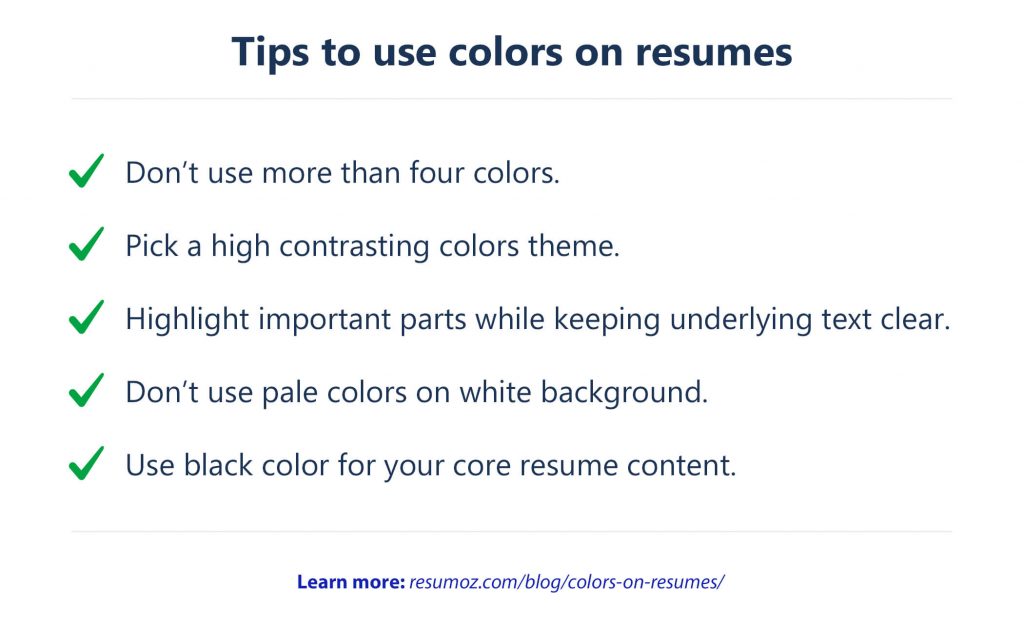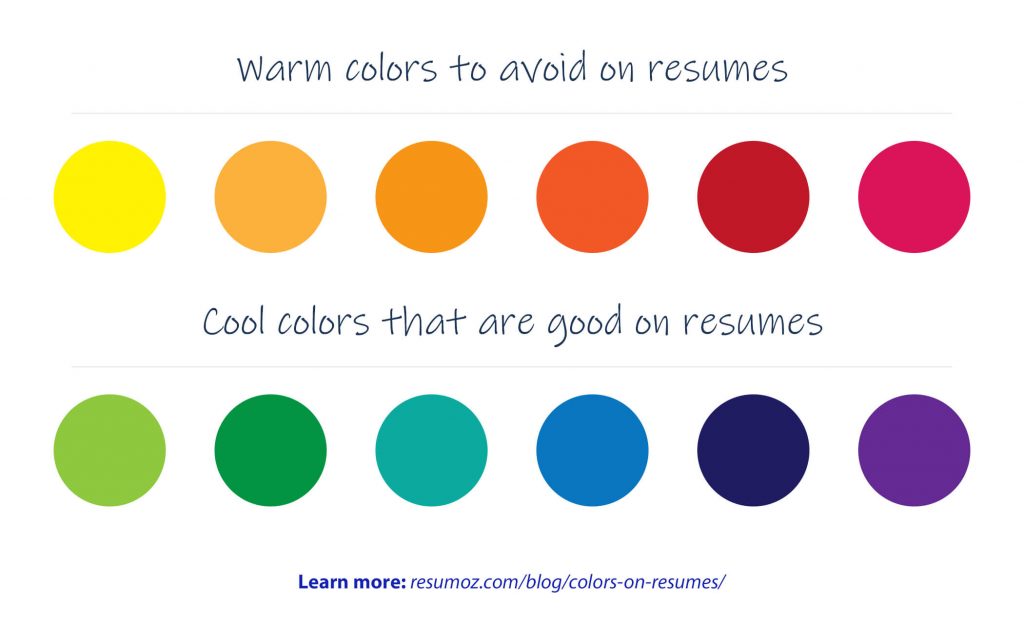For many years, resumes used to be black and white. With the time changes, most job applicants are interested in using colors to make their resume stand out.
Adding different colors to your resume will make your job application more attractive. Adding the right colors on your resume could be a great advantage to win an interview opportunity. But do you know when to use colors on your resume and how to use them effectively?
If not, continue reading this guide to learn how to use resume colors effectively.
Best colors for resumes 2022
Best resume colors 2022 (Top combinations)
- Black and White (Recommended)
- Blue, Black, and White
- Yellow, Black, and White
- Maroon, Black, and White
- Mint, Black, and White
These are just a few examples. Continue reading to learn more about them and how to use those colors properly on your resume.

Best primary colors
- Navy Blue (#201775)
- Dark Blue (#1422B2)
- Blue (#5278D2)
- Blue Green (#009193)
- Dark Grey (#424242)
- Maroon (#771624)
- Red Orange (#AB3717)
- Dark Green (#106F22)
Colors for resume background
- White (#FFFFFF)
- Alice Blue (#F0F8FF)
- Bubbles (#E7FEFF)
- Milky Way (#E8F4F7)
- Morning Mist (#E5EDF1)
- Spring Fog (#ECF1EC)
- Summer Mist (#E1EAEC)
- Latte Froth (#F3F0E8)
- Marble White (#F2F0E6)
- Old Lace (#FDF5E6)
- Raindrops (#ECE5E1)
- Swan White (#F7F1E2)
- Wind Chill (#EFF3F0)
- Soft Mint (#E6F9F1)
- Ghost White (#F8F8FF)
- Cotton Ball (#F2F7FD)
- Pale Grey (#FDFDFE)
- Whitewash (#FEFFFC)
- Polished Pink (#FFF2EF)
- Snow (#FFFAFA)
- Modest Violet (#E9E4EF)
For core resume content
- Black (#000000)
Should we use colors on a resume?
Can my resume colors attract employers? If my prospective employer is a traditional one, would he like to have a color scheme on my resume? There is no universal answer to the question of whether you should use color in your resume. But we can answer that in this way.
It all depends on your job, the job industry, the organization you are going to apply for, and the particular company’s culture.
Some job industries do not accept resumes that are created by combining different colors because they are so traditional and more conservative. In such industries, the recruiters pay more attention to the content of the resume than the visual presentation of the resume. Therefore it’s wise to go with a black and white resume color theme if you’re planning to apply below jobs.
- Financial Jobs
- Law
- Government / Federal Jobs
- Conservative Jobs
But if you are applying for jobs in the tech industry or marketing, media, design, etc. effective use of colors will be genuinely helpful to make your resume stand out. Also, if you apply to a startup, they will even check your designing skills through the appearance of your resume.
Including a color scheme on your resume is completely acceptable and safe if you’re applying for these types of careers:
- Graphic Designer
- Web Developer
- Interior Designer
- Fashion Designer
- Photographer
- Actor
- Brand Executives
- Journalist
- Content Writer
- Floral designer
- Art director
- Make-up artist
- Visual artist
- Game artist
- Animator
Furthermore, the nature of the person inspecting your resume can impact the use of colors on your resume for better or worse. But we can not predict whether your resume will be tested by which type of person.
So the best thing you can do is to design your application using resume color best practices as mentioned below in this article. That way you can create a perfect resume to get a positive first impression by using different shades of colors without harming the creativity and professionalism of your resume.
However our advice for you is not to spend too much time on choosing a color for your resume. Invest your valuable time focusing on the resume content instead.
Why should you be concerned about the resume color
If you are not aware of the benefits of applying a beautiful color theme to your resume, then the following points will help you to get a rough idea.
01. To make a positive first impression
Scientific evidence has also shown that the use of color in a resume makes it somewhat easier to catch the reader’s attention and makes your resume more memorable. Getting your desired job will not be so difficult if your resume is designed to get the attention of the hiring manager.
02. To highlight key information
One thing we all know is that hiring managers and recruiters are very busy people. So they do not even take so much time to scan your resume. They only pay attention to the key details contained in your resume in the shortest possible time. But if you can highlight the key areas of your resume using different colors, it will undoubtedly be helpful for the hiring manager. So that it can draw the reader’s attention to your resume and they may even be impressed with your skills and achievements within a short period of time.
03. To show your creativity and professionalism
Hiring managers can measure your designing skills, attention to detail, and personality with your resume. Especially if you are applying for a job like Graphic Designing, UI / UX, Branding, Interior Designing, or Web Development, it is very important to have design skills. So the proper usage of colors in your resume could be a definite factor in getting you hired.
04. To make your candidacy stand out
Of all the job applications, your resume must be outstanding if the hiring manager wants to select you for the relevant position. This means that you will only get a call for an interview if your resume stands out. It’s not a hard thing to make your candidacy stand out for the relevant position, if you’re able to use colors on your resume consistently.
Where to add colors on resume?
There are some areas on a resume where colors can be used effectively. The important thing is to include the primary color in the resume header. It is a common practice to add white lettering to the surface of a resume header when using a primary color. This results in a great contrast between the resume heading and the text, as well as clear visibility.
When adding subtitles to your resume, you may also use color. You can highlight the section title with a primary color and insert the text on it in white, or you can just insert the section title text with a primary color without highlighting it.
How to add a color scheme on a resume?
Here’s the step by step guide on using the right balance of color on your resume in order to highlight the key information in your resume.

01. Choose a good color scheme
Picking a safe color scheme for your resume is crucial when you’re applying for any job. Our recommendation is to use white for the background, black for the text, and another color to highlight key information or resume titles.
It is always a safe option to avoid using high contrasting and bright colors as it can make your resume unprofessional. Also don’t use pale colors on white background as it could be a distraction for the reader.
If possible, use the same color theme in your cover letter as you use in your resume. This will help to create a professional image of yourself in the recruiter’s mind.
02. Make sure the colors you picked are right for your resume
Just choosing a color scheme is not enough. You need to make sure that even your hiring manager likes it. If the hiring manager is attracted to your resume, you win. But we do not know what colors they preferred to have on resumes.
Therefore, one of the smart hacks you can do is colorize your resume to match the theme color of the company. Try to fit their culture. Also make sure the color scheme is consistent throughout your resume. This can often lead to successful results for you.
03. Incorporate color to emphasize content
You can easily break up and distinguish information from the resume by applying colors to subtitles such as Work Experience, Education, Skills on your resume. Also, you can make your resume stand out by simply using white as the background color, black as the core resume content and Navy Blue, Gray, or Green as the third color which is the dominant color of your resume. The proper use of color should always complement the content and resume format.
04. Don’t pick two primary resume colors
When you create your resume avoid choosing two dominant colors to be on your resume. This will create a distraction for the reader for sure. If you do want to use two colors other than black and white, choose a primary color and a decent pale color as the secondary color. Going beyond four colors in a resume is a big no-no.
Keep in mind that your resume will go through an electronic scan before it goes to a recruiter’s hand. If you use too many colors on your resume, your application won’t get parsed through the ATS. So make sure that there is a high contrast between the text and the background of your resume.
No design experience? Use Black & White
If you don’t have designing skills and a proper understanding of color combination, then avoid playing with colors in your resume. Instead, it is best to go for a black and white color theme. But if you think it’s essential for your resume to have a certain color, try to use beautifully designed resume templates on our website.
The meanings of resume colors
Red – It is the color of rapid growth, passion and energy. Red colored resumes attract recruiters’ attention like no other color and motivates employers to take action. However, it can also evoke negative emotions such as anger, danger, and aggression. As a result, deeper shades of red, such as maroon or burgundy, should be used on resumes.
Orange – To show your energy, excitement, enthusiasm, and productivity to a recruiter, use orange color on your resume. It is best to use an orange colored resume if you are expecting to apply for a job in a startup.
Yellow – Do you want to convince your future employer that you are a positive and a happy person? If so, add yellow on your resume. Highlighting resume section titles in yellow is a good way to help you get noticed.
Green – Represents the environment, growth, harmony, hope, generosity, and serenity. Therefore, using green color on your resume is ideal when applying for eco-friendly jobs or if your career history demonstrates slow but consistent growth. Also green is a relaxing color to be on any resumes.
Blue – This is the color of loyalty and trust. If you feel confident and secure in your career, blue will be the ideal color to be on your resume. Also this is an ideal color choice for the resumes of those who are trying to obtain jobs in IT and non-profit industries.
Purple – Purple symbolizes royalty, luxury, creativity and inspiration. In many cases, top managers and c-suite executives have their resumes designed in purple shades.
Frequently asked questions about resume colors
01. Warm colors or cool colors for resumes?
No matter what job you’re applying for, avoid using warm colors. It will be inconvenient for the reader who reads the resume. Therefore, if possible, choose cool colors instead. Below are some examples of warm colors to avoid and alternative cool colors.

02. How many colors should you use maximum on a resume?
The more colors your resume has, the more it will cause confusion. As a result, it will be a hindrance to the reader. So limit the amount of colors in your resume to a minimum. There is no problem in using only two more colors besides black and white. You can use up to four colors on your resume, but three is an ideal number to start with.
03. What should be the background color of my resume?
The most appropriate color for the background of your resume is white. However, if you want to give your resume a more creative and modern touch, use just extremely light colors. Otherwise, using bright colors as the background color will reduce the visibility of the text on that surface. In addition to white, these colors can be used as the background color for your resume.
04. What are the drawbacks of colored resumes?
Colorful resumes aren’t always accepted by traditional employers. They’re more concerned with the content of the resume than with its presentation. As a result, always include keywords in your resume to ensure that the content matches the job description, and try to create a resume with a rich content.

